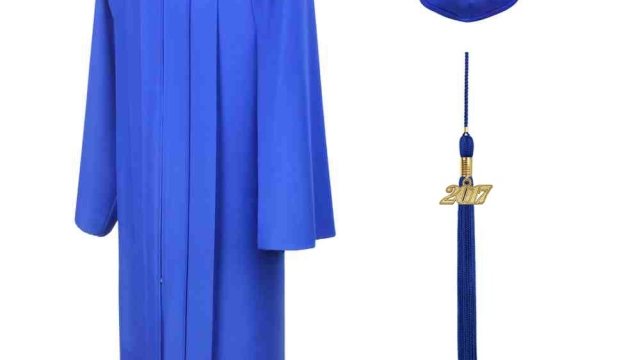Graduation day is a momentous occasion in a student’s life, representing the culmination of years of hard work and dedication. As we eagerly await this milestone, one iconic symbol takes center stage: the graduation cap and gown. These traditional garments carry a depth of meaning, symbolizing the achievements, accomplishments, and successes of the graduating class.
The graduation cap, also known as the mortarboard, is a distinctive piece of headwear that has been worn by graduates for centuries. Its square shape with a flat top has become universally recognized as a symbol of academic achievement. The cap’s origins can be traced back to the medieval era when scholars would wear such head coverings to distinguish themselves as intellectuals. Today, the cap’s flat top, adorned with a tassel, serves as a reminder of the knowledge and academic excellence attained during a student’s educational journey.
As important as the graduation cap is, the gown holds equal significance. The traditional graduation gown, typically black in color, has roots that can be traced back to the early universities of medieval Europe. The gown was initially worn as a practical garment to protect scholars from the cold, damp halls of academia. Over time, it evolved into a prestigious attire symbolizing the elevated status and intellectual pursuits of those who wear it.
In modern times, the graduation gown has become a uniform of achievement and distinction. Its flowing silhouette and vibrant sash colors differentiate graduates based on their degree, field of study, or the institution they represent. Each color tells a unique story, celebrating the diverse accomplishments and specialization of graduates across various academic disciplines.
As we prepare to don our graduation caps and gowns, let us reflect on the profound symbolism they carry. In the sea of black gowns and mortarboards, we stand united as individuals who have overcome challenges, expanded our knowledge, and contributed to the world of academia. So, let the cap’s tassel swing in the wind, and wear the gown with pride, for they represent an extraordinary chapter in our lives that will be cherished forever.
The History of Graduation Caps and Gowns
The tradition of wearing graduation caps and gowns dates back centuries, with its roots deeply intertwined with the history of academic institutions. These iconic outfits symbolize the importance and significance of academic achievements.
During the Middle Ages, universities started to emerge as centers of knowledge and learning. As early as the 12th century, long before graduation ceremonies became commonplace, scholars would wear distinctive robes to distinguish themselves from the general population. These robes, often associated with religious garments, marked their status as individuals of intellectual pursuit.
Over time, the wearing of academic robes became more formalized, and the graduation ceremony evolved as a way to honor students who had completed their studies. It was during the 14th and 15th centuries that graduation attire began to resemble the cap and gown we recognize today. Scholars would don long gowns to signify their academic aspirations, while the inclusion of a cap, known as a mortarboard, symbolized the transition from student to graduate.
The tradition of wearing graduation caps and gowns spread throughout Europe, and eventually crossed the Atlantic to the United States. As universities and colleges were established across the country, this tradition remained an integral part of graduation ceremonies. Today, the sight of graduates donning these traditional garments evokes a sense of accomplishment, unity, and a shared commitment to education.
university cap and gown
###2. The Symbolic Meaning
Graduation caps and gowns are not just ordinary attire but hold symbolic significance for graduates around the world. These traditional garments carry profound meanings that go beyond their aesthetic appeal.
Firstly, the graduation cap, also known as the mortarboard, represents the culmination of academic achievement. Its square shape with a flat top symbolizes the knowledge and wisdom that graduates have gained throughout their educational journey. The tassel attached to the cap holds its own symbolism as well. Positioned initially on the right side, it is traditionally moved to the left once the diploma is conferred, signifying the successful completion of studies.
Secondly, the gown worn during graduation ceremonies represents the overall academic accomplishment of a graduate. Typically made of black fabric, the gown’s length and sleeves can vary depending on the level of education being conferred. The black color symbolizes the maturity and seriousness with which graduates approach their future endeavors.
Furthermore, the academic hood, a key component of the graduation ensemble, represents the graduate’s specific field of study. These hoods are often adorned with different colors, indicating various academic disciplines. The length, shape, and colors of the hood’s lining reflect the specific achievements and honors earned by the graduate, serving as a visible testament to their academic dedication.

In conclusion, graduation caps and gowns hold deep symbolic meaning within the academic world. They represent the hard work, perseverance, and knowledge gained by graduates throughout their educational journey. These ceremonial garments are not merely clothing items but powerful symbols of achievement and success.
3. Modern Trends and Variations
In recent years, graduation caps and gowns have seen a surge in modern trends and variations. These changes reflect the evolving nature of graduation ceremonies and the desire for individuality among graduates.
One notable trend is the incorporation of different fabrics and colors into the traditional gown. Many universities now offer a variety of gown colors, allowing graduates to choose a shade that represents their field of study or personal preference. For example, a psychology graduate may opt for a gown in a calming shade of blue, while a business graduate might choose a distinguished black gown. This trend adds a touch of uniqueness to each graduate’s ensemble, showcasing their individuality and achievements.
Another modern trend is the addition of personalized accessories to the traditional cap and gown. Graduates are increasingly adorning their caps with decorative elements such as feathers, flowers, or rhinestones. These embellishments serve as a reflection of the graduate’s personality and accomplishments, and can also be used to signify membership in various academic or cultural organizations. By personalizing their caps, graduates are able to further express their individuality and create lasting memories of their special day.
Furthermore, some universities have introduced themed graduation ceremonies, which allow graduates to wear attire that reflects their shared interests or major field of study. For instance, a school with a strong focus on environmental studies may encourage graduates to wear graduation gowns made from sustainable materials or incorporate eco-friendly elements into their attire. Themed ceremonies not only add an element of fun and excitement to the graduation experience but also promote a sense of camaraderie and unity among the graduating class.
As graduation caps and gowns continue to evolve, these modern trends and variations reaffirm their significance as symbols of achievement and individuality. Graduates are no longer confined to traditional styles but have the freedom to express themselves in a way that resonates with their personal journey and academic accomplishments.
